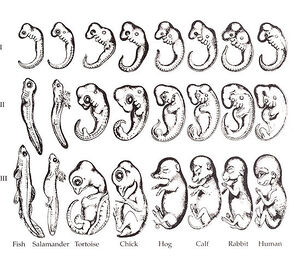Recapitulation theory (nonfiction): Difference between revisions
(Created page with "The '''theory of recapitulation''', also called the biogenetic law or embryological parallelism—often expressed using Ernst Haeckel's phrase "ontogeny recapitulates phylogen...") |
No edit summary |
||
| Line 1: | Line 1: | ||
The '''theory of recapitulation''', also called the biogenetic law or embryological parallelism—often expressed using Ernst Haeckel's phrase "ontogeny recapitulates phylogeny"—is a historical hypothesis that the development of the embryo of an animal, from fertilization to gestation or hatching (ontogeny), goes through stages resembling or representing successive stages in the evolution of the animal's remote ancestors (phylogeny). | [[File:Haeckel_drawings.jpg|thumb|George Romanes's 1892 copy of Ernst Haeckel's controversial embryo drawing.]]The '''theory of recapitulation''', also called the biogenetic law or embryological parallelism—often expressed using [[Ernst Haeckel (nonfiction)|Ernst Haeckel]]'s phrase "'''ontogeny recapitulates phylogeny'''"—is a historical hypothesis that the development of the embryo of an animal, from fertilization to gestation or hatching (ontogeny), goes through stages resembling or representing successive stages in the evolution of the animal's remote ancestors (phylogeny). | ||
It was formulated in the 1820s by Étienne Serres based on the work of Johann Friedrich Meckel, after whom it is also known as Meckel-Serres law. | It was formulated in the 1820s by [[Étienne Serres (nonfiction)|Étienne Serres]] based on the work of [[Johann Friedrich Meckel (nonfiction)|Johann Friedrich Meckel]], after whom it is also known as Meckel-Serres law. | ||
Since embryos also evolve in different ways, the shortcomings of the theory had been recognized by the early 20th century, and it had been relegated to "biological mythology" by the mid-20th century. | Since embryos also evolve in different ways, the shortcomings of the theory had been recognized by the early 20th century, and it had been relegated to "biological mythology" by the mid-20th century. | ||
| Line 19: | Line 19: | ||
== Nonfiction cross-reference == | == Nonfiction cross-reference == | ||
* [[ (nonfiction)]] | * [[Ernst Haeckel (nonfiction)]] | ||
* [[Johann Friedrich Meckel (nonfiction)]] | |||
* [[Étienne Serres (nonfiction)]] | |||
External links: | External links: | ||
Revision as of 07:34, 18 March 2018
The theory of recapitulation, also called the biogenetic law or embryological parallelism—often expressed using Ernst Haeckel's phrase "ontogeny recapitulates phylogeny"—is a historical hypothesis that the development of the embryo of an animal, from fertilization to gestation or hatching (ontogeny), goes through stages resembling or representing successive stages in the evolution of the animal's remote ancestors (phylogeny).
It was formulated in the 1820s by Étienne Serres based on the work of Johann Friedrich Meckel, after whom it is also known as Meckel-Serres law.
Since embryos also evolve in different ways, the shortcomings of the theory had been recognized by the early 20th century, and it had been relegated to "biological mythology" by the mid-20th century.
Analogies to recapitulation theory have been formulated in other fields including cognitive development and art criticism.
In the News
Fiction cross-reference
Nonfiction cross-reference
External links:
- Recapitulation theory @ Wikipedia
